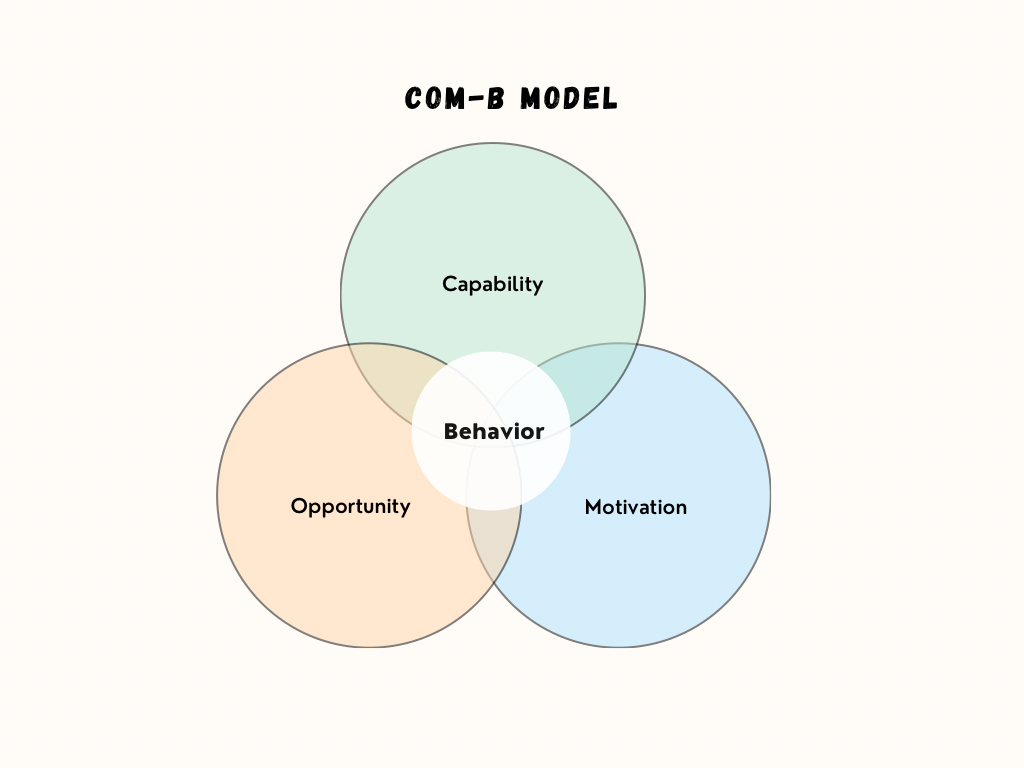In the dynamic world of digital product management, understanding user behavior is key to success. Every product manager wants to craft products that truly resonate with the users. The COM-B model, with its roots in behavioral science, provides a clear roadmap that can help you to achieve this. Let’s have a look at the model and how it might support you as a product manager.
A Brief History of the COM-B Model
The COM-B model was developed by Professors Susan Michie, Maartje M. van Stralen, and Robert West in 2011. It emerged as a synthesis of 19 frameworks of behavior change, aiming to provide a comprehensive understanding of how behavior is influenced. The model posits that for a behavior to occur, three essential components must be present: Capability, Opportunity, and Motivation. These components interact in various ways, leading to the behavior in question.

Capability, Opportunity, and Motivation explained
Capability
Capability refers to an individual’s physical and psychological ability to engage in a specific behavior. It’s about whether users have the necessary knowledge, skills, and attributes to perform the behavior.
Physical Capability: This relates to one’s physical ability to engage in an activity.
Example: Consider a fitness app. If the app is designed for advanced workouts without modifications for beginners, users who aren’t physically fit might find it challenging to engage with the app.
Psychological Capability: This encompasses the knowledge and psychological skills required.
Example: Think of a complex project management software. If a user doesn’t understand project management jargon or methodologies, they might struggle to use the software effectively.
How To Enhance Capability:
- Offer tutorials, guides, and FAQs.
- Provide different user modes (e.g., beginner, intermediate, advanced).
- Use clear, jargon-free language.
Opportunity
Opportunity pertains to external factors that make a behavior possible or prompt it. It’s about the environment or context that enables or restricts behavior.
Physical Opportunity: Provided by the environment, it relates to factors that can promote or inhibit behavior.
Example: A meditation app might offer offline capabilities, allowing users to meditate even in areas without internet connectivity.
Social Opportunity: This is about the societal influences that can guide behavior.
Example: Social media platforms thrive on this. The more friends a user has on a platform, the more they’re likely to engage, post, and interact.
How To Enhance Opportunity:
- Ensure the product is accessible across devices and conditions (e.g., offline mode).
- Incorporate social features, like sharing or collaborating.
Motivation
Motivation drives behavior. It includes the conscious decision-making processes, habits, and emotional responses.
Reflective Motivation: This involves conscious decisions and evaluations. It’s the more “rational” side of why we do things.
Example: A user might choose a password manager app because they’ve evaluated the risks of weak passwords and decided they need a tool to manage strong, unique passwords for each account.
Automatic Motivation: This relates to emotions, impulses, and ingrained habits.
Example: Think of the “pull-to-refresh” feature in many apps. It’s become an automatic behavior for many users, driven by the anticipation of new content.
How To Enhance Motivation:
- Highlight the benefits and value of the product.
- Use gamification elements to make engagement habitual and rewarding.
- Design with user emotions in mind, ensuring a positive user experience.
Utilizing the COM-B Model in Digital Product Management
- User Research and Capability: Begin by understanding your users’ capabilities. Are they familiar with the kind of technology you’re offering? Do they have the necessary skills to use your product effectively? If not, consider incorporating onboarding tutorials or user guides.
- Designing for Opportunity: Ensure that your product provides users with the right opportunities. This could mean optimizing for mobile use if your users are always on the go or integrating with other platforms they frequently use.
- Motivating Users: This is where gamification can play a role. Rewards, badges, and leaderboards can motivate users to engage with your product. But remember, motivation also comes from creating a product that genuinely adds value to their lives.
- Iterative Testing: Use the COM-B model as a lens during user testing. Are there capability issues you didn’t spot? Are users motivated but find a lack of opportunity? Iterative testing will help you refine your product based on these insights.
- Feedback Loops: Encourage user feedback and act on it. If users feel that a particular feature is too complicated (capability issue) or feel that a feature doesn’t add value (motivation issue), consider these insights in your product iterations.